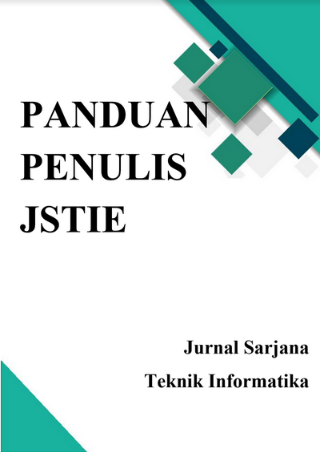THEME GENERATOR CMS WORDPRESS MENGGUNAKAN TEKNOLOGI HTML 5 UNTUK MEMPERMUDAH PEMBUATAN THEME SEBAGAI MEDIA PROMOSI (STUDI KASUS : SYNCHRONOUS, YOGYAKARTA)
DOI:
https://doi.org/10.12928/jstie.v2i2.2846Abstract
Efisiensi dalam pembuatan theme pada distro synchronous sangat diperlukan, akan tetapi pada distro synchronous belum mempunyai apilikasi untuk mempermudah pembuatan Theme sehingga dalam pembuatan dan pengubahan theme mengalami kesulitan hingga harus melalui proses coding untuk mengubah dan pembuatan theme. Tujuan dari penelitian ini adalah dapat memudahkan distro Synchronous, Yogyakarta dalam proses pembuatan theme.
Dalam penelitian ini yang menjadi subyek adalah Theme Generator dimana nanti akan dikembangkan sebuah Theme Generator Pada CMS Wordpress menggunakan teknologi HTML 5 yang bertujuan untuk memudahkan pembuatan dan pengubahan theme tanpa melalui proses coding dimana nantinya element –element di dalam theme akan disajikan dengan fitur drag dan juga drop. Metode pengumpulan data dengan metode wawancara, observasi dan study literature. Tahap pengembangan aplikasi meliputi analisis system, perancangan system,  implementasi system, dan pengujian. Teknologi yang digunakan adalah HTML 5 dan pengujian sistem dengan black box test dan white box serta melakukan uji nilai T menggunakan paired t test.
           Hasil dari penelitian yang dilakukan adalah terbentuknya Theme Genartor CMS Wordpress Menggunakan Teknologi HTML di Synchronous Yogayakarta Dari pengujian terdapat perbedaan signifikan dalam tingkat kecepatan pembuatan theme pada CMS Wordpress setelah dibangunnya aplikasi Theme Generator, hal ini mengacu dengan didapatnya nilai p < 0.05 dari hasil pengujian paired t test. Theme Generator yang telah dibuat memiliki pengaruh terhadap peningkatan efektifitas dan kecepatan kerja dari Synchronous distro yang terintegrasi, dengan begitu distro synchronous dapat segera mempublish produk- produk terbaru untuk di promosikan.
Â
Kata Kunci : : Theme Generator, Theme, HTML 5.References
Fitriningsih. 2006. Pembuatan E-Comerce Templates sebagai media informasi dan pemasaran studi kasus SEGARA ITC Distributor. UAD.
Arifudin M. 2007 mempercepat proses pemanggilan script video dalam website ADITV Dengan Menggunakan metode Embeded Video.
Joe lennon, Create modern Web sites using HTML5 and CSS3 ( implementing the canvas and video elements in HTML5).
Dewi Agustina. Analisa Streaming Online TV Menggunakan Metode Client Server dan Peer To Peerâ€. Universitas Gunadarma
Rachel Mccollin. Profesional theme & plugin development â€(implementing themes & plugin development)
Depdiknas. 2003. The New Teknologi HTML5. Jakarta : Pusat Kurikulum, Badan Penelitian dan Pengembangan Depdiknas.
W3Scholls. 2013. Learning HTML 5 : Diakses 18 Januari 2014 http://w3scholls.com
Harjono, Widagdo. 2007. Rekayasa Perangkat Lunak. Jakarta: Erlangga.
Himawan. 1998. Pembangunan Perangkat Lunak Perancang Halaman Web HTML Sederhana. ITS
Bob Julius Onggo. 2009. Cyber Branding Cyber Marketing.
Downloads
Published
Issue
Section
License
License and Copyright Agreement
In submitting the manuscript to the journal, the authors certify that:
- They are authorized by their co-authors to enter into these arrangements.
- The work described has not been formally published before, except in the form of an abstract or as part of a published lecture, review, thesis, or overlay journal. Please also carefully read Journal Posting Your Article Policy.
- The work is not under consideration for publication elsewhere.
- The work has been approved by all the author(s) and by the responsible authorities – tacitly or explicitly – of the institutes where the work has been carried out.
- They secure the right to reproduce any material that has already been published or copyrighted elsewhere.
- They agree to the following license and copyright agreement.
Copyright
Authors who publish with Jurnal Sarjana Teknik Informatika agree to the following terms:
- Authors retain copyright and grant the journal right of first publication with the work simultaneously licensed under a Creative Commons Attribution License (CC BY-SA 4.0) that allows others to share the work with an acknowledgement of the work's authorship and initial publication in this journal.
- Authors are able to enter into separate, additional contractual arrangements for the non-exclusive distribution of the journal's published version of the work (e.g., post it to an institutional repository or publish it in a book), with an acknowledgement of its initial publication in this journal.
- Authors are permitted and encouraged to post their work online (e.g., in institutional repositories or on their website) prior to and during the submission process, as it can lead to productive exchanges, as well as earlier and greater citation of published work.







